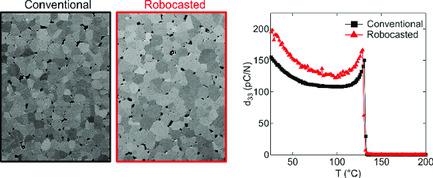当前位置:
X-MOL 学术
›
Adv. Eng. Mater.
›
论文详情
Our official English website, www.x-mol.net, welcomes your feedback! (Note: you will need to create a separate account there.)
Electromechanical Properties of Robocasted Barium Titanate Ceramics
Advanced Engineering Materials ( IF 3.6 ) Pub Date : 2020-06-10 , DOI: 10.1002/adem.202000325 Mylena Lorenz 1 , Alexander Martin 1 , Kyle G. Webber 1 , Nahum Travitzky 1, 2
Advanced Engineering Materials ( IF 3.6 ) Pub Date : 2020-06-10 , DOI: 10.1002/adem.202000325 Mylena Lorenz 1 , Alexander Martin 1 , Kyle G. Webber 1 , Nahum Travitzky 1, 2
Affiliation

|
This work presents the fabrication of dense polycrystalline barium titanate (BaTiO3, BT) for electromechanical transduction using robocasting and cold isostatic pressing (CIP). The use of CIP as post‐treatment is proposed to eliminate defects and increase the density of robocasted parts to improve the piezoelectric performance. For robocasting, pastes containing 50 and 52 vol% are developed; the resulting green robocasted parts are CIPed at 100 and 150 MPa. Using this proposed technique, samples robocasted with BT52 and CIPed at 150 MPa display a relative density of ≈98%, comparable with reference polycrystalline samples. In addition, an increase in both the piezoelectric charge and voltage coefficient is observed in robocasted parts, with the values up to 195 pC/N and 12 × 10−3 Vm N−1, respectively. These values, which are comparable with previous studies of polycrystalline BT, indicate that the combined robocasting and CIP technique is a possible method for producing 3D printed piezoelectric sensors.
中文翻译:

机械铸造钛酸钡陶瓷的机电性能
这项工作介绍了使用机械浇铸和冷等静压(CIP)进行机电转换的致密多晶钛酸钡(BaTiO 3,BT)的制备。建议使用CIP作为后处理,以消除缺陷并增加机械铸造零件的密度,以改善压电性能。为了进行机器人广播,开发了含量为50%和52%(体积)的糊剂。在100和150 MPa下对所得的绿色机械铸造零件进行CIP处理。使用此提议的技术,用BT52机器人铸造并在150 MPa下CIP喷涂的样品显示出约98%的相对密度,与参考多晶样品相当。另外,在机器人铸造零件中观察到压电电荷和电压系数的增加,其值高达195 pC / N和12×10 -3 Vm N-1。这些值与先前对多晶BT的研究相当,表明机器人广播和CIP组合技术是生产3D打印压电传感器的一种可能方法。
更新日期:2020-06-10
中文翻译:

机械铸造钛酸钡陶瓷的机电性能
这项工作介绍了使用机械浇铸和冷等静压(CIP)进行机电转换的致密多晶钛酸钡(BaTiO 3,BT)的制备。建议使用CIP作为后处理,以消除缺陷并增加机械铸造零件的密度,以改善压电性能。为了进行机器人广播,开发了含量为50%和52%(体积)的糊剂。在100和150 MPa下对所得的绿色机械铸造零件进行CIP处理。使用此提议的技术,用BT52机器人铸造并在150 MPa下CIP喷涂的样品显示出约98%的相对密度,与参考多晶样品相当。另外,在机器人铸造零件中观察到压电电荷和电压系数的增加,其值高达195 pC / N和12×10 -3 Vm N-1。这些值与先前对多晶BT的研究相当,表明机器人广播和CIP组合技术是生产3D打印压电传感器的一种可能方法。


























 京公网安备 11010802027423号
京公网安备 11010802027423号